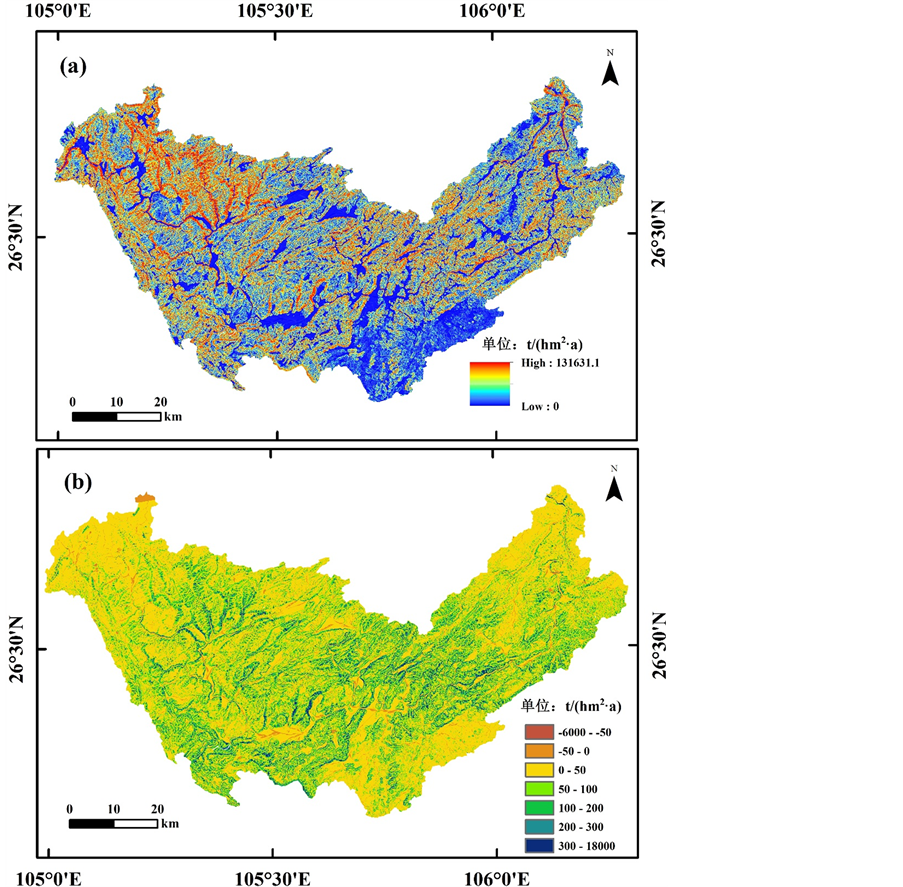1. 引言
土地是人类赖以生存和发展的重要资源和物质基础,直接影响经济发展和社会进步 [1] - [4] 。目前,在气候变化和人类活动的共同影响下,全球范围内土壤侵蚀问题严重 [5] - [8] 。土壤侵蚀不仅会引起土地退化、土壤肥力下降,还会影响河流的正常泄洪以及水电工程的使用寿命 [9] ,已经成为威胁人类社会生存和发展的全球性环境问题 [10] [11] 。土壤保持作为生态系统服务的一项重要调节功能,为国家生态环境建设和水土宏观决策的制定提供了重要依据 [12] 。
在土壤侵蚀评估方面,全球范围内已经开展了卓有成效的研究工作。美国学者在20世纪70年代,提出了土壤流失通用方程USLE (Universal Soil Loss Equation),专门用于土壤侵蚀的研究 [13] 。USLE的创建以及GIS技术的迅猛发展,为区域尺度上生态系统土壤保持功能的量化提供了可能 [14] 。中国从20世纪80年代开始运用通用土壤流失方程对区域土壤侵蚀强度进行了研究,并对方程的参数进行了大量的探讨 [15] [16] 。国内外学者将USLE方程运用于区域土地利用变化与土壤侵蚀相互关系、土壤保持量及其生态服务价值等研究 [17] [18] 。Ghosh等 [19] 运用USLE评估了Tripura的潜在土壤流失和实际土壤流失,探索Tripura的土壤侵蚀情况,分析Tripura最易受到侵蚀的区域;Dabral等 [20] 运用USLE、GIS和RS对印度东北部的丘陵区小流域土壤侵蚀进行了评估。肖玉等 [21] 利用USLE方程评估青藏高原土壤保持量,研究发现不同生态系统的土壤保持效益强度也不同,森林系统植被覆盖率高于其他类型,其土壤保持量高于草地和农田生态系统。冯磊等 [22] 运用GIS方法和USLE土壤侵蚀模型,分析评价区域退耕还林还草工程建设前后的土壤侵蚀变化状况,研究得出实施退耕还林还草工程之后区域土壤侵蚀得到有效控制,退耕还林还草工程对水土保持起到了明显的积极作用。
USLE考虑了降水、土壤性质、地形、植被覆盖和管理因子 [23] ,是目前使用最广泛的土壤侵蚀模型,该方法能较为准确地反映区域土壤侵蚀状况,但在计算土壤保持量时忽略了地块自身的泥沙持留能力,存在一定偏差 [24] 。InVEST (The Integrate Valuation of Ecosystem Services and Tradeoffs Tool)模型中的土壤保持模块很好的解决了这个问题。InVEST模型,即生态系统服务功能综合估价和权衡得失评估模型,是美国斯坦福大学、TNC和世界自然基金会合作联合开发的生态系统服务评估模型,旨在探索生态系统的变化如何引起人类利益的变化 [25] 。该模型的土壤保持模块在USLE的基础上,还考虑到地块自身拦截上坡土壤侵蚀物的能力,使土壤保持量的计算结果更为准确 [24] 。Ren等 [26] 利用InVEST模型评估了长江流域上游的土壤保持量;李婷等 [27] 采用InVEST土壤保持模型,从研究区、流域、县域3个尺度,对秦岭潜在和实际土壤侵蚀量进行计算,并应用该模型量化该研究区的土壤保持生态服务价值。
中国喀斯特山区地质环境脆弱、生态敏感度高,由于人口超载和经济社会落后,生态环境严重退化,正面临着水资源短缺、水土流失、石漠化等问题 [28] [29] ,制约了西南喀斯特地区区域经济和社会发展 [30] [31] 。苏维词 [32] 论述了贵州喀斯特山区土壤侵蚀性退化,林昌虎等 [33] 通过对贵州喀斯特山区的分析研究,认为贵州喀斯特山区的土壤侵蚀,主要是因为不合理的土地利用,再加之外部的地质、地貌、降水等诸多因素所致。因此,处理好喀斯特区域的土壤侵蚀问题,对恢复喀斯特山区生态系统稳定,解决人口、粮食、资源和环境之间的矛盾,维持人与自然和谐,保障区域可持续发展具有重要意义。本研究运用InVEST模型评估三岔河流域1990年、2010年土壤保持量,分析三岔河流域土壤保持的时空变化,揭示不同土地利用类型土壤保持能力的变化,希望对评估三岔河流域生态环境变化,促进区域可持续发展起到支持作用。
2. 研究区概况
贵州省三岔河流域位于东经104˚59'~106˚18',北纬26˚09'~26˚49'之间,流域面积约4860.69 km2 (图1)。三岔河流域以三岔河为干流,河流全长325.6 km,发源于贵州省西部乌蒙山威宁县。三岔河流域所包含的行政区域包括纳雍县、织金县、水城县、清镇市、平坝县、六枝特区、镇宁县、安顺市和普定县。三岔河地处滇东高原向黔中丘陵过度地带,流域海拔在866~2279 m之间。区域内高原山地约占80%,高原丘陵约占15%,平地约占5%。三岔河流域除西北部威宁县地势较高地区属于暖温带外,其余地区均属于亚热带季风气候区,气候温和湿润,且随地势和纬度的变化而变化。
3. 方法与数据
3.1. 土壤保持模型
InVEST模型将量化的生态系统服务功能以地图的形式表现出来,拥有包括土壤保持、生物多样性、碳储量、产水量等在内的多个模块。本文拟利用InVEST模型中的土壤保持模块评估三岔河流域的土壤保持能力。该土壤保持模块根据地形地貌和气候条件评估潜在土壤流失量,通过通用土壤流失方程评估土壤保持能力,土壤保持量包含侵蚀减少量和泥沙持留量。模型计算过程如下 [13] 。
首先,计算裸地潜在土壤侵蚀量,裸地潜在土壤侵蚀量计算公式如下:
 (1)
(1)
其中,R为降雨侵蚀力,K为土壤可蚀性,LS为坡长坡度因子。

Figure 1. The location of the Sancha River Basin
图1. 三岔河流域位置示意图
其次,在植被覆盖与工程措施的情形下,运用通用土壤流失方程计算潜在土壤流失,公式如下:
 (2)
(2)
其中R为降雨侵蚀力,K为土壤可蚀性,LS为坡长坡度因子,C为植被覆盖和和管理因子,P为工程措施因子。
对于不同地物类型潜在土壤侵蚀的评估通过与裸地的潜在土壤侵蚀进行比较而得到,即RKLS减去USLE即为土壤保持量。
降雨侵蚀力反应降雨引起土壤侵蚀的潜在能力,是土壤侵蚀的主要动力之一,降雨侵蚀力的大小与其他降雨侵蚀参数如降雨量、降雨历时、降雨强度和降雨动能等的相关性特别强,本文采用Wischmeier [13] [34] 经验公式进行计算:
 (3)
(3)
其中, 为月均降雨量,
为月均降雨量, 为年均降雨量。
为年均降雨量。
土壤可蚀性K是土壤侵蚀方程的重要指标,体现了土壤对侵蚀因子的敏感性,通用土壤流失方程中K表示标准小区中单位将于侵蚀力因子的土壤流失量,本文采用Williams等 [35] 人建立的EPIC (Erosion- Productivity Impact Calculator) 公式进项计算,即:
 (4)
(4)
其中,san、sil、cla、c分别代表土壤中沙粒、粉粒、粘粒、有机碳的含量(%), 。
。
地形因子LS反映了坡度和地表状况之间的关系,是雨滴或泥沙流动直到能量消失为止的距离,反应地形地貌特征对土壤侵蚀的影响。模型对于不同的坡度,能自动计算地形因子的值,根据实际情况,本文将坡度阈值设置为25%,当坡度小于坡度阈值时,计算方法 [36] 如下:
 (5)
(5)
其中,
 (6)
(6)
当坡度大于坡度阈值时,地形因子计算方式 [36] 如下:
 (7)
(7)
其中,
 (8)
(8)
式中, 、
、 、
、 、
、 、
、 分别代表为汇水累积阈值、栅格大小、坡度、百分数坡度、坡长指数。
分别代表为汇水累积阈值、栅格大小、坡度、百分数坡度、坡长指数。
地表覆盖管理因子C是指在土壤、地形和降雨相同的条件下,某一个特定作物或自然植被状况下土壤流失量与耕作后的土壤流失量之比,主要受土壤水分、前期土地利用方式、植被作物种植顺序等影响,反映植被或作物以及管理措施对土壤流失的影响,该值介于0~1之间。土壤保持措施因子P是采用专门措施后土壤流失量与顺坡种植时的土壤流失量的比值,反映植被的管理措施差异引起的土壤流失量差别,是抑制土壤侵蚀的重要因子之一,其范围在0~1之间。
3.2. 数据来源
运行土壤保持模型所需的数据包括:土地利用图,DEM,降雨量数据,土壤沙粒、粉粒、粘粒、有机碳的含量数据。其中,土地利用数据包括三岔河流域1990年、2010年的土地利用数据由973项目课题组提供;DEM数据来源于地理空间数据云,降雨量数据来中国气象数据网,土壤沙粒、粉粒、粘粒、有机碳的含量数据来源于中国科学院资源环境科学数据中心。
4. 结果与分析
4.1. 三岔河流域土地利用变化
三岔河流域主要的土地利用类型为草地,面积占40%以上,其次是耕地,比重大约为30%。此外,林地的面积也占流域面积的25%以上,而水域、建设用地、未利用地面积较小,均不超过1%。
从1990年到2010年,三岔河流域林地、水域和建设用地面积呈增长的趋势。其中,面积变化最大的林地面积增长了22.80 km2 (1.81%) (表1),其次是水域,增长了5.62km2 (26.42%),建设用地则增长了0.56 km2 (5.14%);耕地、草地和未利用地呈减少的趋势,其中减少最多的是草地,减少了28.79 km2 (1.35%),其次是耕地,减少了0.18 km2 (0.01%),未利用地减少了0.01 km2 (0.85%)。
4.2. 土壤保持时空变化
三岔河流域土壤保持量在空间上存在显著差异(图2)。1990年,三岔河流域的土壤保持量在0~131631.11 t/(hm2∙a)之间,2010年,三岔河流域的土壤保持量在0~135913.33 t/(hm2∙a)之间。空间上,三岔河流域土壤保持量低值区主要分布在流域的东南部,高值区主要分布在西北部。
1990年,三岔河流域的土壤保持总量为2.72 × 108t/a,平均土壤保持量为564.0.7 t/(hm2∙a),2010年,三岔河流域的土壤保持总量为3.04 × 108 t/a,平均土壤保持量为632.65 t/(hm2∙a),在自然和社会因素的共同影响下,三岔河流域土壤保持量增加了0.33 × 108 t/a,增长率为达到了12.03%,平均土壤保持量增加了68.59 t/(hm2∙a)。
空间上,从1990年到2010年,三岔河流域土壤保持量多在增加,增加量在0~18,000 t/(hm2∙a)之间不等,增长的量大多在0~50 t/(hm2∙a)之间,多分布于地势较为平坦的西北、东北和东南地区,其他地区也有零星的分布,在地势由高到低的中部地区和西南地区增加量大多在50 t/(hm2∙a)以上,也有少部分区域土壤保持量在减少,减少量在−6000-0 t/(hm2∙a)之间不等,但是多在−50~0 t/(hm2∙a)之间,且多分布于三岔河沿岸地区(图2)。
4.3. 不同土地利用类型土壤保持特征
不同的地利用类型土壤保持总量有明显差异。不同土地利用类型土壤保持总量从大到小为:草地>林地>耕地>建设用地>未利用地。其中,草地的土壤保持量最多,占总量40%以上(表2),林地土壤保持量占总量的30%左右,耕地占总量的20%左右。草地、林地和耕地提供了土壤保持量的占总量的90%以上。1990~2010年,各土地利用类型的土壤保持总量都呈现出不同程度的增长,增长速率最快的是建设用地,增长率为22.08%,增长了0.05 × 106 t/a,耕地、林地、草地的增长率均在12%左右,增长量分别

Table 1. Land use changes of Sancha River Basin from 1990 to 2010
表1. 1990~2010年三岔河流域土地利用变化

Figure 2. Soil conservation in 1990 (a) and changes of soil conservation from 1990 to 2010 (b)
图2. 1990年土壤保持量(a)与1990~2010年土壤保持量变化(b)

Table 2. Soil conservation and its changes of different land use types from 1990 to 2010
表2. 1990~2010年不同土地利用类型土壤保持量及其变化
为7.12 × 106 t/a、10.51 × 106 t/a、14.97 × 106 t/a,未利用地的增长率最小,总量仅增长了8.42%,增长量仅有1000 t/a。
不同的地利用类型土壤保持功能也具有明显差异。平均土壤保持量从大到小为:林地>草地>耕地>建设用地>未利用地(表2),而从1990年到2010年,各种土地利用类型的平均土壤保持量均有不同程度的增长,其中建设用地的增长率最高为15.88%,平均增长量为36.55 t/(hm2∙a),耕地和草地的增长率都在12%左右,其平均增长量分别为51.53 t/(hm2∙a)、82.29 t/(hm2∙a),林地和未利用地的增长率都在10%左右,平均增长量分别为73.22 t/(hm2∙a)、4.99 t/(hm2∙a)。
5. 讨论与结论
生态系统土壤保持功能受土壤、气候条件、地形地貌、土地利用、人类活动以及社会经济等因素影响,InVEST模型综合考虑到了以上多个因素,其评估结果较为准确。InVEST模型评估结果显示,1990年三岔河流域的土壤保持总量为2.72 × 108 t/a,平均土壤保持量为564.07 t/(hm2∙a),2010年,三岔河流域的土壤保持总量为3.04 × 108 t/a,平均土壤保持量为632.65 t/(hm2∙a),其结果远低于海南、福建等地区,主要原因在于:三岔河流域是典型的喀斯特地貌,环境容量低、生态环境脆弱、地形崎岖破碎,区域内人口、粮食、资源和环境之间的矛盾日益尖锐,所以相对于其他区域,三岔河流域土壤保持功能较弱。而从1990年到2010年,三岔河流域的土壤保持量有明显的增加,三岔河流域土壤保持总量增加了0.33×108 t/a,增长率为达到了12.03%,平均土壤保持量增加了68.59 t/(hm2∙a)。从20世纪90年代末以来,我国实行了“退耕还林还草”政策,对我国的水土保持做出了很大贡献,在很大程度上缓减了我国的水土流失问题,对改善生态环境起到了很好的作用。
空间上,三岔河流域土壤保持量低值区主要分布在流域的东南部,高值区主要分布在西北部,究其原因,一方面,三岔河流域地形较为复杂,地势陡峭,区域内降雨量存在较大的差异,降雨量从北向南逐渐增加,故而区域内潜在土壤侵蚀量有显著差异,另一方面,由于土地利用情况不同,植被覆盖度不一,造成了土壤保持能力差异。因此,形成了三岔河流域内空间分布相对复杂的局面。
三岔河流域不同的土地利用类型土壤保持总量大小为:草地 > 林地 > 耕地 > 建设用地 > 未利用地,且草地、林地和耕地提供了土壤保持量的占总量的90%以上,三岔河流域的土地利用类型主要以草地为主,占总面积的40%以上,耕地和林地的面积占比也都在20%以上,而建设用地、未利用地的面积相对较小,三种类型的总面积占比不超过10%,
生态系统通过冠层、地被层和土壤层的共同作用,可以减少侵蚀和阻挡泥沙。不同的土地利用类型减少侵蚀和阻挡泥沙的能力不同,林地植被覆盖度高,根系深,故其土壤保持能力最强;草地也有较高的植被覆盖度,可以阻挡泥沙,土壤保持能力较强;耕地种植农作物,而且耕地有一定的保护措施,能阻挡泥沙,减少土壤侵蚀量,其土壤保持能力仅次于林地和草地;建设用地、未利用地的土壤保持能力较小,建设用地形成了不透水层能减少侵蚀,未利用地的土壤保持能力最差,未利用地皆为裸露的地面,几乎没有阻挡泥沙、减少侵蚀的能力。
综上所述,三岔河流域的土壤保持情况复杂,受到自然条件和社会经济发展的双重影响,维持土壤保持功能对生态系统平衡发展至关重要,所以合理开发资源,加强生态系统的管理和保护,缓减人口、粮食、资源和环境之间的矛盾,权衡区域的经济发展与生态环境的关系,才能保证区域的可持续发展。
基金项目
国家重点基础研究发展计划(973计划) (2015CB452702)与国家自然科学基金(41501192)联合资助。